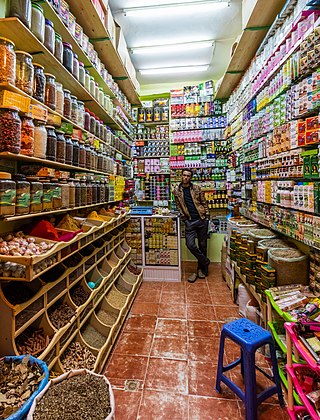
Shopping is an activity in which a customer browses the available goods or services presented by one or more retailers with the potential intent to purchase a suitable selection of them. A typology of shopper types has been developed by scholars which identifies one group of shoppers as recreational shoppers, that is, those who enjoy shopping and view it as a leisure activity.

Retail is the sale of goods and services to consumers, in contrast to wholesaling, which is sale to business or institutional customers. A retailer purchases goods in large quantities from manufacturers, directly or through a wholesaler, and then sells in smaller quantities to consumers for a profit. Retailers are the final link in the supply chain from producers to consumers.

A grocery store (AE), grocery shop (BE) or simply grocery is a foodservice retail store that primarily retails a general range of food products, which may be fresh or packaged. In everyday U.S. usage, however, "grocery store" is a synonym for supermarket, and is not used to refer to other types of stores that sell groceries. In the UK, shops that sell food are distinguished as grocers or grocery shops (though in everyday use, people usually use either the term "supermarket" or a "corner shop".

Distribution is the process of making a product or service available for the consumer or business user who needs it, and a distributor is a business involved in the distribution stage of the value chain. Distribution can be done directly by the producer or service provider or by using indirect channels with distributors or intermediaries. Distribution is one of the four elements of the marketing mix: the other three elements being product, pricing, and promotion.
Venison originally meant the meat of a game animal but now refers primarily to the meat of deer. Venison can be used to refer to any part of the animal, so long as it is edible, including the internal organs. Venison, much like beef or pork, is categorized into specific cuts, including roast, sirloin, and ribs.
Bauer & Cie. v. O'Donnell, 229 U.S. 1 (1913), was a 1913 United States Supreme Court decision involving whether a purchaser of a patented product bearing a price-fixing notice incurs guilt of patent infringement by reselling the product at a price lower than that which the notice commands. A divided Court (5–4) held that it was not.

A butcher is a person who may slaughter animals, dress their flesh, sell their meat, or participate within any combination of these three tasks. They may prepare standard cuts of meat and poultry for sale in retail or wholesale food establishments. A butcher may be employed by supermarkets, grocery stores, butcher shops and fish markets, slaughter houses, or may be self-employed.
Ground beef, minced beef or beef mince is beef that has been finely chopped with a knife, meat grinder, mincer or mincing machine. It is used in many recipes including hamburgers, bolognese sauce, meatloaf, meatballs, and kofta.

Online shopping is a form of electronic commerce which allows consumers to directly buy goods or services from a seller over the Internet using a web browser or a mobile app. Consumers find a product of interest by visiting the website of the retailer directly or by searching among alternative vendors using a shopping search engine, which displays the same product's availability and pricing at different e-retailers. As of 2020, customers can shop online using a range of different computers and devices, including desktop computers, laptops, tablet computers and smartphones.

Retail loss prevention is a set of practices employed by retail companies to preserve profit. Loss prevention is mainly found within the retail sector but also can be found within other business environments.
A jobber, or petroleum marketer, is a person or company that purchases quantities of refined fuel from refining companies, either for sale to retailers, or to sell directly to the users of those products. In essence, the jobber acts as the "middleman" between the company that refines the petroleum products and those that use them or market them at retail prices. The jobber often owns the gasoline being sold, and the station it is being sold to, but allows an operator to lease the store.

A meat cutter prepares primal cuts into a variety of smaller cuts intended for sale in a retail environment. The duties of a meat cutter largely overlap those of the butcher, but butchers tend to specialize in pre-sale processing, whereas meat cutters further cut and process the primal cuts per individual customer request.

Jobbers Canyon Historic District was a large industrial and warehouse area comprising 24 buildings located in downtown Omaha, Nebraska, US. It was roughly bound by Farnam Street on the north, South Eighth Street on the east, Jackson Street on the south, and South Tenth Street on the west. In 1989, all 24 buildings in Jobbers Canyon were demolished, representing the largest National Register historic district loss to date.

Dressed weight refers to the weight of an animal after being partially butchered, removing all the internal organs and often the head as well as inedible portions of the tail and legs. It includes the bones, cartilage and other body structure still attached after this initial butchering. It is usually a fraction of the total weight of the animal, and an average of 59% of the original weight for cattle. There is no singular way to dress an animal, as what is removed depends on whether it will be cooked whole or butchered further for sale of individual parts. For pigs, the dressed weight typically includes the skin, while most other ungulates are typically dressed without. For fowl, it is calculated with skin but without feathers. It can be expressed as a percentage of the animal's live weight, when it is known as the killing out percentage.
United States v. Parke, Davis & Co., 362 U.S. 29 (1960), was a 1960 decision of the United States Supreme Court limiting the so-called Colgate doctrine, which substantially insulates unilateral refusals to deal with price-cutters from the antitrust laws. The Parke, Davis & Co. case held that, when a company goes beyond "the limited dispensation" of Colgate by taking affirmative steps to induce adherence to its suggested prices, it puts together a combination among competitors to fix prices in violation of § 1 of the Sherman Act. In addition, the Court held that when a company abandons an illegal practice because it knows the US Government is investigating it and contemplating suit, it is an abuse of discretion for the trial court to hold the case that follows moot and dismiss it without granting relief sought against the illegal practice.
Jobber, in merchandising, can be synonymous with "wholesaler", "distributor", or "intermediary". A business which buys goods and bulk products from importers, other wholesalers, or manufacturers, and then sells to retailers, was historically called a jobbing house. A jobber is a merchant—e.g., (i) a wholesaler or (ii) reseller or (iii) independent distributor operating on consignment—who takes goods in quantity from manufacturers or importers and sells or resells or distributes them to retail chains and syndicates, particularly supermarkets, department stores, drug chains, and the like. One objective is to distribute goods at lower costs through economies of scale, which, in sophisticated operations, typically uses complex transportation models. In competitive markets, the practice is an integral part of supply chain management—one that might incorporate, among other things, operations research in areas of logistics involving supply chain networking, and supply chain optimization. A jobber is very different from a broker. A broker transacts on behalf of a merchandiser while a jobber supplies inventory at a merchandiser's site for consumers to purchase.
Countries regulate the marketing and sale of beef by observing criteria of cattle carcasses at the abattoir (slaughterhouse) and classifying the carcasses. This classification, sometimes optional, can suggest a market demand for a particular animal's attributes and therefore the price owed to the producer.
The retail format influences the consumer's store choice and addresses the consumer's expectations. At its most basic level, a retail format is a simple marketplace, that is; a location where goods and services are exchanged. In some parts of the world, the retail sector is still dominated by small family-run stores, but large retail chains are increasingly dominating the sector, because they can exert considerable buying power and pass on the savings in the form of lower prices. Many of these large retail chains also produce their own private labels which compete alongside manufacturer brands. Considerable consolidation of retail stores has changed the retail landscape, transferring power away from wholesalers and into the hands of the large retail chains.
Branch house refers to a meat industry building that combined a sales office and warehouse for the disposition of packing-house products at a distance from the packing plant. Branch houses were typically located in densely populated areas, and received meat shipments from the slaughterhouse, often daily by rail. Some branch houses would do further processing, including smoked meats, and sausage making.











